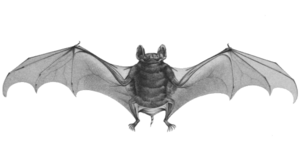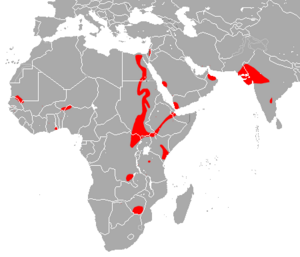Egyptian tomb bat facts for kids
The Egyptian tomb bat (Taphozous perforatus) is a type of sac-winged bat. It belongs to a family of bats called Emballonuridae. This bat is a medium to large microbat, which means it's a small bat. It weighs about 30 g (1.1 oz), which is like a few pieces of candy. It flies around in open areas to catch insects in the air. Scientists in Ethiopia found that these bats mostly eat moths. They also eat termites, beetles, and crickets.
Quick facts for kids Egyptian tomb bat |
|
|---|---|
 |
|
| Illustration accompanying the original species description. | |
| Conservation status | |
| Scientific classification | |
| Genus: |
Taphozous
|
| Species: |
perforatus
|
 |
|
| distribution | |
| Synonyms | |
|
|
Contents
About Egyptian Tomb Bats
How Big Are They?
The Egyptian tomb bat's body length is usually between 64.8–80 mm (2.55–3.15 in). Different types of these bats can be slightly different sizes. Their forearms are about 60.2–65.3 mm (2.37–2.57 in) long. Their ears are also quite long, measuring 15–23 mm (0.59–0.91 in).
Different Types of Egyptian Tomb Bats
Scientists recognize four main types, or subspecies, of the Egyptian tomb bat. These types are found in different parts of the world.
- T. p. senegalensis — Found in West Africa.
- T. p. perforatus — Found in Egypt and northern Sudan.
- T. p. sudani — Found in Southern Sudan, eastern Democratic Republic of the Congo, Botswana, and Zimbabwe.
- T. p. haedinus — Found from Tanzania through Ethiopia and in South Asia.
Bat Life and Habits
What Do They Eat?
Scientists studied the bats' poop to learn what they eat. They found that these bats mostly eat moths, which make up about 57% of their diet. Other insects they enjoy include:
- Termites (14%)
- Beetles (10%)
- Katydids and crickets (8%)
- Bugs (3%)
- Lacewings (2%)
- Ants (1%)
- Flies (1%)
How Do They Have Babies?
Baby bats are called pups. Scientists have seen young bats and mothers feeding their babies in July. It is thought that baby bats are usually born in late May and early June. These bats can get pregnant more than once a year. They can even be feeding one baby while pregnant with another!
Bat Health and Parasites
Like many animals, Egyptian tomb bats can have tiny creatures living on them. These are called ectoparasites. Scientists have found different types of fleas, bat-flies, ticks, and mites on these bats. These tiny creatures don't usually harm the bats too much.
Bat Genetics
Scientists have studied the genes of Egyptian tomb bats. They found that these bats have 42 chromosomes. Chromosomes are like tiny instruction manuals inside every living thing.
Bats and Science
Scientists have studied Egyptian tomb bats to learn about viruses. A type of virus called MERS-CoV was found in a bat near where a person became sick. This discovery helped scientists understand more about how viruses can spread. It showed that bats can carry certain viruses.
Where Do They Live?
The first Egyptian tomb bats studied by scientists were found in a place called Kom Ombo in Egypt. These bats live in many countries across Africa and Asia. You can find them in:
- Benin
- Botswana
- Burkina Faso
- Democratic Republic of the Congo
- Djibouti
- Egypt
- Ethiopia
- Gambia
- Ghana
- Guinea-Bissau
- India
- Iran
- Kenya
- Mali
- Mauritania
- Niger
- Nigeria
- Pakistan
- Saudi Arabia
- Senegal
- Somalia
- Sudan
- Tanzania
- Uganda
- Zimbabwe
These bats like dry savanna areas. In South Asia, they prefer tropical thorn forests. They usually stay away from very dry deserts and thick forests. You won't find them living higher than 200 m (660 ft) above sea level.
Protecting Egyptian Tomb Bats
The IUCN says the Egyptian tomb bat is a species of "least concern". This means they are not currently in danger of disappearing. There are many of them, they live in a wide area, and their numbers seem stable. However, in South Asia, their homes in the thorn forests are being destroyed. These forests are being cut down for farming, mining, and stone quarries. Protecting these forests is important for the bats.


